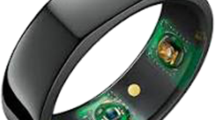Abstract
We describe a mobile health application that collects data relevant to the treatment of insomnia and other sleep-related problems. The application is based on the principles from neuroergonomics, which emphasizes assessment of the brain’s alertness system in everyday, naturalistic environments, and ubiquitous computing. Application benefits include the ability to incorporate both embedded data collection and retrospective manual data input—thus providing the user with a rewarding data access process. The retrospective data input feature was evaluated by comparing an older version of the retrospective editing interface with a newly developed one. The time course of user interactions was precisely measured by exporting time stamps of user interactions using the Google App Engine. We also developed models that closely fit the time course of user interactions using the Goals, Operators, Methods, and Selection rules (GOMS) modeling method. The user data and GOMS models demonstrated that the retrospective sleep tracking feature of the new interface was faster to use but that the retrospective habit tracking feature was slower. Survey results indicated that participants enjoyed using the newly developed interface more than the old interface for the assessment of both sleep and habits. These findings indicate that a mobile application should be designed not only to reduce the amount of time it takes a user to input data, but also to conform to the user’s mental models of its behavior.




Similar content being viewed by others
References
Duh HB, Tan GC, Chen VH (2006) Proceedings of the 8th conference on Human-computer interaction with mobile devices and services. ACM, New York, pp 181–186
Parasuraman R, Rizzo M (2007) Neuroergonomics: the brain at work. Oxford University Press, New York
Wickens CD, Hollands JG (2000) Engineering psychology and human performance, 3rd edn. Prentice Hall, Upper Saddle River
Gazzaniga MS (2009) The cognitive neurosciences, 4th edn. MIT Press, Cambridge
Parasuraman R (2011) Neuroergonomics: brain, cognition, and performance at work. Curr Dir Psychol Sci 20:181–186
Parasuraman R (2003) Neuroergonomics: research and practice. Theor Issues Ergon Sci 4:5–20
Rizzo M, Robinson, S, Neale V (2007) The brain in the wild: tracking human behavior in naturalistic settings. In: Parasuraman R, Rizzo M (eds) Neuroergonomics: the brain at work. Oxford University Press, New York
Kientz JA (2011) Embedded capture and access: encouraging recording and reviewing of data in the caregiving domain. Pers Ubiquit Comput, 1–13
Abowd GD, Mynatt ED (2000) Charting past, present, and future research in ubiquitous computing. ACM Trans Comput Hum Interact 7(1):29–58
Truong KN, Hayes GR (2009) Ubiquitous computing for capture and access. Found Trends Hum Comput Interact 2(2):95–171
Sa M, Carrico L, Antunes P (2007) Ubiquitous psychotherapy. IEEE Pervasive Comput 6:20–27
Taylor DJ, Schmidt-Nowara W, Jessop C, Ahearn JJ (2010) Sleep restriction therapy and hypnotic withdrawal versus sleep hygiene education in hypnotic using patients with insomnia. J Clin Sleep Med 6:169–175
Mori C, Bootzin R, Buysse D, Edinger J, Espie C, Lichstein K (2006) Psychological and behavioral treatment of insomnia: update of the recent evidence (1998–2004). Sleep 29(11):1398–1414
Purves B, Purves D (2007) Computer based psychotherapy for treatment of depression and anxiety. In: 14th annual IEEE international conference and workshops on the engineering of computer-based systems, 334–338
Stone AA, Shiffman S, Schwartz JE, Broderick JE, Hufford MR (2003) Patient compliance with paper and electronic diaries. Control Clin Trials 24(2):182–199
Taylor DJ, Lichstein KL, Weinstock J, Sanford S, Temple J (2007) A pilot study of cognitive-behavioral therapy of insomnia in people with mild depression. Behav Ther 38:49–57
Morin CM, Colecchi C, Stone J, Sood R, Brink D (1999) Behavioral and pharmacological therapies for late-life insomnia: a randomized controlled trial. JAMA 281(11):991–999
Jacobs GD, Pace-Schott EF, Stickgold R, Otto MW (2004) Cognitive behavior therapy and pharmacotherapy for insomnia: a randomized controlled trial and direct comparison. Arch Intern Med 164(17):1888–1896
Ritterband LM, Thorndike FP, Gonder-Frederick LA (2009) Efficacy of an Internet-based behavioral intervention for adults with insomnia. Arch Gen Psychiatry 66(7):692–698
Vincent N, Lewycky S (2009) Logging on for better sleep: RCT of the effectiveness of online treatment for insomnia. Sleep 32(6):807–815
Morris M, Intille SS, Beaudin JS (2005) Embedded assessment: overcoming barriers to early detection with pervasive computing. In: Gellersen HW, Want R, Schmidt A (eds) Proceedings of pervasive, pp 333–346
Siek KA, Connelly KH, Rogers Y (2006) Pride and prejudice:learning how chronically ill people think about food. In: Proceedings of the SIGCHI conference on human factors in computing systems (CHI ‘06). ACM, New York, pp 947–950
Mamykina L, Mynatt ED (2005) Role of community support in coping with chronic diseases: a case study of diabetes support group. HCI International, Las Vegas
Strom L, Pettersson R, Andersson G (2004) Internet-based treatment for insomnia: a controlled evaluation. J Consult Clin Psychol 72(1):113–120
Gartenberg D (November 2010) Sleep and health on the smart phone: Applications towards behavioral treatment for Insomnia. Sleep Review Magazine 12–15
Gartenberg D, Parasuraman R (2010) Understanding Brain Arousal and Sleep Quality Using a Neuroergonomic Smart Phone Application. In: Marek T, Karwowski W, Rice V (eds) Advances in Understanding Human Performance, 3rd International Conference on Applied Human Factors and Ergonomics 210–220
Author information
Authors and Affiliations
Corresponding author
Rights and permissions
About this article
Cite this article
Gartenberg, D., Thornton, R., Masood, M. et al. Collecting health-related data on the smart phone: mental models, cost of collection, and perceived benefit of feedback. Pers Ubiquit Comput 17, 561–570 (2013). https://doi.org/10.1007/s00779-012-0508-3
Received:
Accepted:
Published:
Issue Date:
DOI: https://doi.org/10.1007/s00779-012-0508-3




